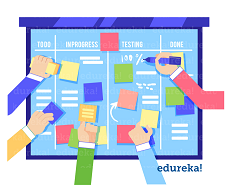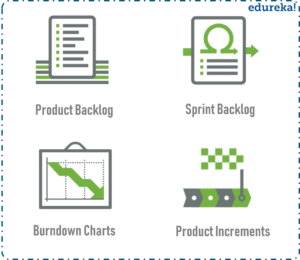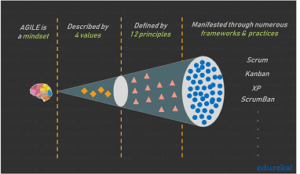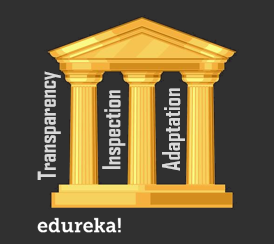Electric Vehicle (EV) Foundation Training Cou ...
- 1k Enrolled Learners
- Weekend/Weekday
- Live Class
Scrum Framework is quickly becoming the framework of choice for teams interested in adopting an agile philosophy. Given the growth in the fame of the Scrum Framework, it should come as no surprise that this growth is also fueling an unprecedented demand for Scrum Master Certification.
Here are the top 50 scrum master interview questions that would help you get a step closer to your dream scrum master job.
Let’s begin by taking a look at the most frequently asked questions in Scrum Master Interview Questions.
Q10. What is a story point in scrum? How do you calculate it?
For better understanding, I have divided the rest of the Scrum Master Interview Questions into the following sections:
Let’s begin with the first section of Scrum Master Interview questions.
The questions under this category are all technical questions based on Agile, Scrum Framework, and Scrum Master related. Basically, by asking these questions you are being tested on the subject knowledge and expertise in the field.
This section of Scrum Master Interview Questions will cover all those basic questions that you might come across when attending a scrum job interview.
Q1. What is Agile? Explain Agile in 2 min.
This is a tricky and controversial question since the definition of agile is not commonly agreed upon. Is agile a framework? Is agile a methodology?
Agile is a mindset, a philosophy, more like a way of thinking, a movement focusing on communication, team-thinking, intrinsic motivation, empowerment, innovative walks, flow, and value creation while developing a product.
Q2. When to use Agile Model? Is it suitable in all situations?
A flexible model like agile can be used in cases like, when:
Q3. State some major principles of agile.
Key principles of agile include:
Q4. What is Scrum? How is it different from waterfall model?
Scrum is a lightweight agile framework, within which people can address complex adaptive problems, while productively and creatively delivering products of the highest possible value.
It’s different from the waterfall model in the following ways:
Q5. What is Scrum Sprint? What is the ideal duration for a Sprint?
This is a very common question asked in scrum master interviews. Sprint is a regular, repeated work cycle in scrum methodology during which work is completed and made ready for review. Usually, the duration of a scrum sprint depends upon the size of the project and the number of people working on it. On average, the duration of a sprint is about 4 weeks.
Q6. What are the different roles involved in the Scrum Framework?
The three roles involved in scrum are as follows:

Q7. What are the most important components of Agile?
The most important components that constitute agile are:
Q8. What is the role of a scrum master?
Here’s how you should handle a Scrum Master interview question like this: The Scrum Master is the team’s resident facilitator, responsible for helping all team members follow Scrum’s theories, rules, and practices. They ensure the Scrum Team has everything necessary to complete its work, including removing roadblocks, organizing meetings, and addressing bottlenecks. Interestingly, in fast-paced industries like tech, where agile practices intersect with modern tools like the best crypto casinos in the UK, Scrum Masters often draw parallels between efficient team dynamics and the adaptability required in rapidly evolving sectors. This highlights the importance of facilitating a smooth workflow while managing unforeseen challenges.
Q9. What are the responsibilities of a Scrum Master?
Scrum Master serves Product Owner, Development Team and the Organisation in different ways. Most important responsibilities of a scrum master include:
Q10. What is a story point in scrum? How do you calculate it?
Every feature in scrim is a story. A story point is an arbitrary measure used scrum teams to determine the difficulty of implementing a given story.
Q11. What is a Stroy Board in scrum?
An important principle in Scrum is the idea of transparency. That’s why making things visible for the entire team to see is really important. A big factor of this is the Story Board. It is a visual representation of a software project’s progress which generally has four columns, namely, ‘To do’, In Progress’, ‘Test’, and ‘Done’.

Q12. What is the Daily Stand-Up in Scrum? What do these meetings entail?
Daily Scrum, also known as a stand-up, is a 15-minute daily meeting where the team has a chance to get on the same page and put together a strategy for the next 24 hours. Three major questions that are discussed in this meeting are:
Q13. What are the three main artifacts of Scrum Process?
Artifacts are just physical records that provide project details when developing a product. Scrum Artifacts include:

There is another artifact called burn-up chart, which is discussed in of the following questions below.
Q14. What is a user story in Scrum? How does a good user story look?
A user story is a tool used in Agile software development that represents a small piece of business value that a team can deliver in a sprint. Basically, it creates a simplified description of a user’s requirements. A user story is defined incrementally in three stages:
Q15. What are the burn-up and burn-down charts in scrum?
Burn-Up and Burn-Down Charts are used to trace the progress of the project. The burn-up chart illustrates the amount of work completed, while the burn-down chart illustrates the amount of work remained to complete a project. Remember that the efforts are measured in terms of user stories and not hours.
Q16. What does a scrum burndown chart comprise?

Q17. Mention what is the objective behind holding a Sprint retrospective meeting?
During sprint retrospective, the team discusses what went right, what went wrong, and how to improve. They decide on how to fix the problems and create a plan for improvements to be enacted during the next sprint.
Q18. List some popular agile frameworks. Do you know any other agile methodology apart from scrum?
When you are posed with this sort of question, and if you haven’t used any other frameworks, you can just name few that you might have heard of. Other frameworks that are based on agile are:
Q19. What is term velocity in agile? How is it measured?
Velocity predicts how much work Agile can complete in a sprint and how much time will it require to complete a project. The number is obtained by adding all the story points from the last sprint’s stories.
Q20. What is the release candidate in Scrum?
A Release Candidate in Scrum is a build or version of the software that is ready and can be released to production. Further, testing such as User Acceptance Testing (UAT) may be performed on this version of the product.
Q21. Explain what is a scrum of scrums.
This is one of the commonly asked scrum master interview questions. For example, let’s say there is an active project with seven teams working on it. The number of members of each team is also seven and are responsible to lead their own scrum meeting. But, in order to coordinate and communicate with different teams, they need to organize a separate scrum meeting. This meeting is called the scrum of scrums. The responsible person from each team attends the meeting and discuss their work and progress.

Q22. List some of the popular project management tools that you have heard of.
Some popular tools used in the project management are Rally Software, Version One, XPlanner, EasyBacklog Agilefant, and many others.
Q23. Do you know about Agile Manifesto? Explain in brief.
The Agile Manifesto is a statement that is comprised of 4 key values and 12 principles that form the core of agile. Agile comes in a number of forms. Every subset of agile applies the four values and 12 principles in different ways, but all of them rely on them to guide the development and delivery of high-quality, working software.

Q24. Can you state the four values of Agile Software Development as stated in Agile Manifesto?
The four core values as stated by the Agile Manifesto are:
Q25. What is the Empirical Process Control? How is scrum based on that?
Empirical process control is a core Scrum principle and relies on the three main ideas: transparency, inspection, and adaptation. With empirical process control, you don’t fix the scope of the product nor the processes of how to build it. Instead, you create a small shippable piece of product in short cycles, inspect what and how you create it and adapt the product and the way you build it, with built-in mechanisms for transparency to enable clear inspection.

Q26. What do you know about impediments in Scrum? Give some examples of possible impediments.
Impediments are the obstacles or issues faced by the scrum team which slows down the progress of their work. This could occur due to many reasons like listed below:
As a follow-up question, you might be asked the way to remove any of the impediments that you have mentioned.
Q27. What are some qualities that should be present in a good Agile tester?
Some basic skills that every agile tester should have are:
Q28. Mention some scenarios where using scrum is not suggested?
Not every story about Scrum is a success story. Scrum can fail too. It’s not suggested to use scrum when:
Q29. Do you hold any agile certification? Why did you choose this certification?
This sort of question might seem awkward if you don’t have any certification. In such cases, stay calm and just let the interviewer know if are planning to take any in the future. If yes, then mention why you have that particular certification. For your reference, here are some certifications generally looked by organizations:
Q30. Are you a certified scrum master?
Don’t panic if you don’t have a certification and they ask you this question! Be confident and answer if you have a scrum master certification or not. If you are a certified scrum master, just share the details of your certification like certification type, score obtained, and the year of passing. In case you are not certified to highlight your experience in the particular field and let the interviewer know if you are planning to take one in the future.
Q31. Is it ever suggested to use waterfall over Scrum? If yes, explain when.
When your requirements are simple, well-defined, fully understood, predictable, and are not subjected to change until the completion of the project you could probably go for the waterfall model.
Check out our CSM Certification Training in Top Cities
Q32. What are the drawbacks of using scrum?
Using scrum in such cases poses problems like:
Q33. How does agile development model differ from the waterfall model?
Below give a few major differences between Agile and Waterfall
Q34. Are Agile and Scrum the same?
Agile is a set of methods and practices based on the values and principles expressed in the Agile Manifesto. While Scrum is a framework for handling roles, events, artifacts, and rules/guidelines to implement the Agile Mindset. The table below lists the key differences between Scrum & Agile.
Features | Agile | Scrum |
Nature & Scope | Agile is a mentality and a set of principles | Scrum is a framework that implements agile principles |
Planning | Planning occurs at three levels: release planning, iteration planning, and daily planning | Next sprint is planned after the team has completed the current sprint activities |
Flexibility to Changes | Agile is very flexible and hence adapts to changes very quickly | Rigid framework & there is no much room for frequent changes |
Design & Execution | Agile execution is quite simple and it usually something that isn’t done before | Works on trying new and creative ideas, which yields concise and smart outcomes |
Monitoring Process | Requires detailed tracking & it takes place after every milestone of the overall design | Monitoring takes place after compilation of certain features rather than after each design |
Leadership Role | A leader is accountable for the work done (or not done) by the team | There is no ‘team leader’, instead its fosters a multi-functional and self-organized team |
Mode of Communication | The effective mode of communication is face-to-face within a team on a regular basis | Communication is done on a daily/weekly basis with respect to the schedule |
Estimation Time & Delivery | The priority is always to satisfy the customer by providing continuous delivery of valuable software | Delivers build to clients to get their feedback, after each sprint |
Customer Feedback | Encourages regular feedback during various processes from business users | Regular feedback is taken from end-users but in a more orderly fashion, like after every sprint |
Q35. What is the difference between Epic, User stories & Tasks?
Q36. What is the difference between Sprint and Iteration in Scrum?
Q37.What is the difference between the Sprint Planning Meeting & Sprint Retrospective Meeting?
Q38. How is scrum different from other Iterative models?
Scrum is not just an iterative model but it is also an iterative model with incremental progress. Other popular subsets of agile include KanBan, XP, Lean, FDD, etc.
Q39. If you were to introduce scrum to senior executives how would you do it?
This is a deliberately an open question meant to encourage discussion. First of all, consider yourself a part of the organization. Explain scrum in simple terms and if needed you can even talk about how to create a learning organization that is ready to take risks and try experimentation in order to identify the best product for its customers. There is no specific answer to this question/
Q40. What qualities should a good Scrum Master have? What sort of person do you need to be a great scrum master?
Listed below are some qualities that a good scrum master is expected to have:
Q41. What does servant leadership mean and how does the scrum master fits as a servant leader?
Servant-leadership is all about collaboration, trust, empathy and the usage of power ethically. Scrum master is often called as the servant-leader for the Scrum team.
As a servant-leader scrum master is responsible for:
This way scrum master is both a servent as well as a leader.
Q42. You are in the middle of a sprint and suddenly the product owner comes with a new requirement, what will you do?
This question doesn’t have a fixed answer. You can answer in the way you think right. For example, if I were asked the question I would say ”Add requirement to the product backlog and consider it based on priority in the next sprint. If the priority is really high try to include in the current sprint, after communicating with involved people and stakeholders about the risks involved in doing so”.
Q43. A member of the Scrum team does not want to participate in the sprint planning meetings and considers meeting as a waste of time. How do you deal with that kind of attitude?
As a scrum master, you need to know the status of your team. So, if one of your team members thinks meetings are waste its high time to know why he/she is adopting such a behavior. Since scrum teams are usually of small size, so, each member of the team is really important. As Scrum Master, you should try to talk to the team member individually by asking open-ended questions to find out the reason for not attending the meeting. Try to convince him/her why meetings are an important part of the scrum framework.
If the issue is still not resolved, you can set up a meeting with his reporting manager to talk about the concern and lookout for ways to help the team member.
Q44. What is the main reason for the Scrum Master to be at the Daily Scrum?
Scrum master need not personally attend the daily scrum, he should just make sure that the development team members participate without fail. In case if he/she attends the meeting he/she should:
Q45. Your team is picking reasonable action items but is later not delivering on them. How do you handle this?
As a scrum master, you need to do a follow up to solve the issue. Find out the root cause, see if the problem is due to external factor or internal factor. If it’s because of an external factor, you need to address and eliminate the cause. The team can then catch up during a later sprint. If there is no external impediment, the problem is likely due to motivation, attitude, or personal issues within the team. In that case, you need to encourage team members responsible to do the right thing and overcome the problem.
Q46. How would you coordinate between multiple scrum teams?
The way you can handle multiple teams depends on the size and coupling between those teams, and there are various frameworks to help you with it, like:
Q47. How to measure if Agile is working in your team and organization?
Few indications that help you find out if agile is the right thing for you and your organization or not are:
Q48. One of the Agile Manifesto values says “People over processes”. Isn’t the Scrum master role which enforces “the process” a contradiction?
It is really important to understand what exactly does the enforcement mean and what its boundaries are. Enforcement doesn’t mean forcing the team to follow the process, but it implies putting into practice the core principles of the Scrum to help the team be successful. Scrum Master, the facilitator of the team helps the team achieve its goal. Also, he will try to show the benefits of adopting the processes and help the team acquire an understanding of the scrum processes which is like showing the right path but it is totally up to the team if they want to walk through it or not.
Q49. In case you receive a story on the last day of the sprint to test and you find there are defects, what will you do? Will you mark the story to ‘done’?
A story is said to be ‘done’ only when it is completely developed, has passed QA testing, acceptance criteria ais met and is eligible to be shipped into production. So, if the story you received passes all these conditions then you can add it to the ‘done’ list. In case, if there are defects, the story is partially done and not completely done, you will have to spill it over to next sprint.
Q50. Your team is constantly failing to meet commitments, and its performance velocity is volatile. What might the possible reasons be?
This question basically addresses various issues. There are many possible factors that might combine to make a team’s velocity volatile, like:
Well, that’s it! We have reached the end of the Test Automation Interview Questions Article.
I hope the questions listed in this “Scrum Master Interview Questions” help you crack your interview. Happy learning!
Got a question for us? Please mention it in the comments section of this “Scrum Master Interview Questions” article and we will get back to you as soon as possible. Alternatively, Check out CSM Training by Edureka and get certified!
 Thank you for registering Join Edureka Meetup community for 100+ Free Webinars each month JOIN MEETUP GROUP
Thank you for registering Join Edureka Meetup community for 100+ Free Webinars each month JOIN MEETUP GROUPedureka.co
Impressed by the collection of questions, it felt like I got answers for all my queries as it has good collection of topics.
I have couple of questions, could you please help with answers?
1. How do Scrum masters enact change and continuous improvement to increase productivity of team and qualify deliverables?
2. Strategies you follow in coaching self-organized , cross functional team and Coaching team in organization in which team has not fully adopted scrum or understood?
3.How do you as scrum Master handle senior stake holders and decision makers?
4. How do you evaluate Scrum master performance as a manager/senior scrum master?